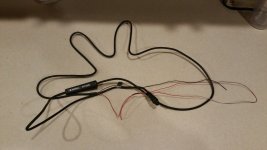mathias999us
New member
Hi Folks,
I've got a new to me 2009 Venture 26. It has two Suzuki SMIS guages at the helm, and apparently the surveyor missed the fact that they are only registering the port tank sender. The starboard tank sender does not appear in the bus device list. I started digging into the wiring around the fuel tanks in the rear, and found that I have two of these devices:
https://www.brownspoint.com/store/pc/pdf/SMIS_Fluid_Level_Manual.pdf
It looks like this is also a direct / rebadged Lowrance EP-65R unit.
One is connected to each tank, and the other ends are connected to the terminal end of the nmea network with T's and finally the terminating resistor.
I've swapped around the connections, and sure enough, the port tank sender reports itself on the network bus device list no matter where I plug it in, and the starboard sender is absent from the list.
I'm new to NMEA stuff. Is there something else I should check, or should I just be looking into ordering another one of these units? Looks like they are about $90.
Is it common for a component like this to go bad?
Thanks,
Mathias
I've got a new to me 2009 Venture 26. It has two Suzuki SMIS guages at the helm, and apparently the surveyor missed the fact that they are only registering the port tank sender. The starboard tank sender does not appear in the bus device list. I started digging into the wiring around the fuel tanks in the rear, and found that I have two of these devices:
https://www.brownspoint.com/store/pc/pdf/SMIS_Fluid_Level_Manual.pdf
It looks like this is also a direct / rebadged Lowrance EP-65R unit.
One is connected to each tank, and the other ends are connected to the terminal end of the nmea network with T's and finally the terminating resistor.
I've swapped around the connections, and sure enough, the port tank sender reports itself on the network bus device list no matter where I plug it in, and the starboard sender is absent from the list.
I'm new to NMEA stuff. Is there something else I should check, or should I just be looking into ordering another one of these units? Looks like they are about $90.
Is it common for a component like this to go bad?
Thanks,
Mathias

